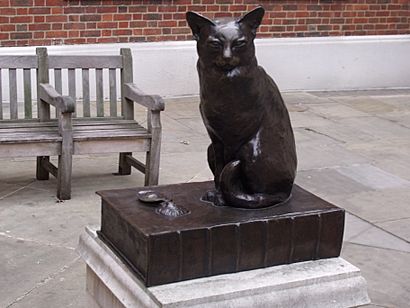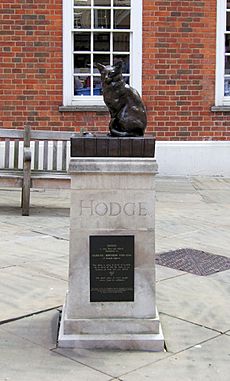Hodge (cat) facts for kids
Hodge was a special cat who lived with the famous writer Samuel Johnson around the year 1769. Johnson, known for creating one of the first English dictionaries, showed a great deal of love for his cat. This was quite unusual for people in the 1700s, making Hodge and Johnson's bond very memorable.
Hodge's Life with Samuel Johnson
Most of what we know about Hodge comes from the writings of James Boswell, Johnson's friend and biographer. Boswell wrote about Johnson's kindness towards his pets. He especially remembered how Johnson treated Hodge.
Johnson would personally go out to buy fresh oysters for Hodge. He did this so his servants wouldn't have the trouble of buying cat food and possibly dislike the cat. In the 1700s, oysters were a common and cheap food, unlike today when they are expensive. Johnson didn't want his servant, Francis Barber, to feel it was beneath him to buy food for a cat.
Boswell also described how Johnson would gently pet Hodge. He recalled seeing Hodge climb onto Johnson's chest. Johnson would smile and hum, stroking Hodge's back and even pulling his tail playfully. When Boswell once said Hodge was a "fine cat," Johnson replied that he had liked other cats more. But then, as if Hodge looked sad, he quickly added, "but he is a very fine cat, a very fine cat indeed." This shows how much Johnson cared about Hodge's feelings.
Johnson also bought a special herb called valerian to help Hodge when he was sick and nearing the end of his life. Even though Johnson had other cats, Hodge was his favorite. After Hodge passed away, his life was celebrated in a poem called An Elegy on The Death of Dr Johnson's Favourite Cat by Percival Stockdale. The poem mentions Hodge's "sable furr," which means he was a black cat.
Remembering Hodge: The Statue
Quick facts for kids A Very Fine Cat Indeed |
|
|---|---|

Statue of Hodge, the cat of Dr Johnson
|
|
| Artist | Jon Bickley |
| Year | 1997 |
| Medium | Bronze sculpture |
| Subject | Hodge the cat |
| Location | Gough Square, City of London |
| 51°30′54″N 0°06′28″W / 51.5150°N 0.1077°W | |
Today, Hodge is remembered with a bronze statue in London. It was placed in 1997 outside Dr Johnson's House in Gough Square, where Johnson, Hodge, and Johnson's servant Francis Barber once lived.
The statue shows Hodge sitting next to empty oyster shells. He is perched on top of a copy of Johnson's famous dictionary. The statue has the words "a very fine cat indeed" carved into it, quoting Johnson's own words. Many visitors who walk by the statue like to place coins in the oyster shells. This is a tradition for good luck. Sometimes, a pink ribbon is tied to the shells or around Hodge's neck for special events.
The sculptor who created the statue is Jon Bickley. He felt a special connection to Samuel Johnson. Bickley said he modeled the statue of Hodge after his own cat, named Thomas Henry. He also made sure the statue was at a good height. This allows people to easily put their arm around it, as if hugging Hodge.


